
October 1, 2022
North Korea fired two short-range ballistic missiles toward the East Sea from the Sunan area in Pyongyang between 6:45 a.m.(KST) and 7:03 a.m.(KST), and the missiles flew some 350 kilometers (217 miles) at apogees of around 30 km (19 mi) at a top speed of Mach 6.
North Korea’s escalation of the tension is thought to be in response to South Korea’s Armed Forces Day(Oct. 1), as well as to a military drill by South, the U.S., and Japan in the East Sea. (source: The Asia Today)
 |
North Korea's tactical ballistic missiles fire on October 1 |
October 4, 2022
North Korea fired an intermediate-range ballistic missile (IRBM) from Mupyong-ri in the northern province of Jagang at 7:23 a.m(KST). The missile flew over Japan about 4,600 kilometers(2,850 miles) before landing in the Pacific Ocean, reaching an apex of 1,000 kilometers and a terminal speed of Mach 17 in its final re-entry phase.
North Korea's missile launch put U.S. military bases in Guam within reach. The U.S. government condemned the launch, and National Security Adviser Jake Sullivan called his Japanese and South Korean counterparts to coordinate a response, the White House said. (source: Korea Joongang Daily)
 |
(source: Kyodo News) |
October 6, 2022
North Korea fired two short-range ballistic missiles from the Samsok area in Pyongyang between 6:01a.m and 6:23 a.m(KST). The missiles flew toward the East Sea, with one flying about 350 km(217 miles) at an apogee of 80 kim(50 miles) and another traveling about 800 km(487 miles) at an altitude of 60 km(37 miles).
These launches came only two days after the North fired an intermediate-range ballistic missile (IRBM) toward Japan and was seen as a response to the USS Ronald Regan being redeployed to the East Sea after the IRBM launch. (source: Yonhap News, Korea Joongang Daily)
.png) |
| North Korea's super-large multiple rocket launchers and tactical ballistic missiles |
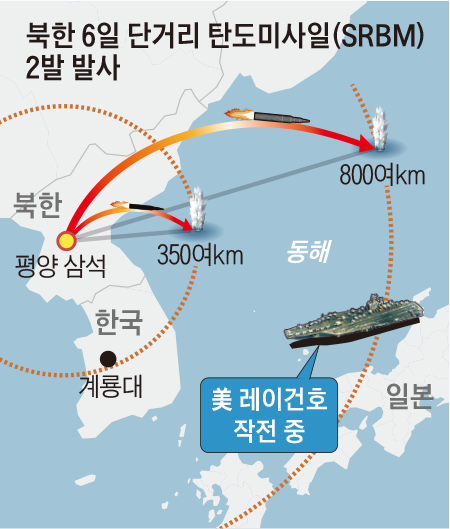 |
(source: Chosun-ilbo) |
October 6, 2022
Around 12 North Korean military aircraft, including 8 fighter jets and 4 bombers, carried out air-to-surface firing exercises at 2:00 p.m(KST) for an hour near the inter-Korean air border and breached South Korea's "special reconnaissance line."
The ROK military sets special reconnaissance lines for surveillance purposes to the north of an agreed inter-Korean airspace buffer zone near the border. The buffer zone, outlined in the 2018 inter-Korean military agreement, extends to a maximum of 25 miles (40 kilometers) from the Military Demarcation Line (MDL), dividing the Koreas on the eastern side and 12.5 miles (20 kilometers) on the western side. (source: NK News)
.png) North Korea's provocations with multiple rockets and ballistic missiles |
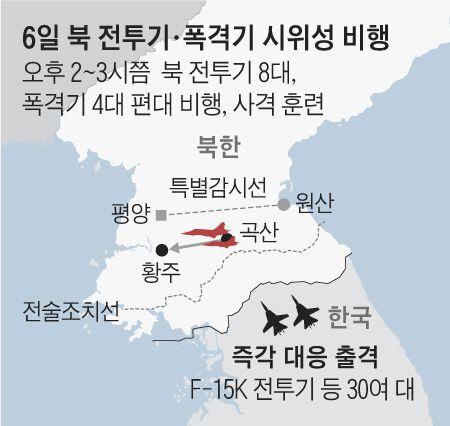 |
(source : Chosun-ilbo) |
October 9, 2022
North Korea fired two short-range ballistic missiles from Munchon in Gangwon province. The first missile was launched at 1:48 a.m., followed by a second at 1:58 a.m. The missiles flew approximately 350 kilometers (217 miles) at Mach 5, reaching altitudes of 90 kilometers, the Joint Chiefs of Staff (JCS) said in a statement. (source: Korea Joongang Daily)
.png) |
South Koreans watching TV about North Korea's missile launch |
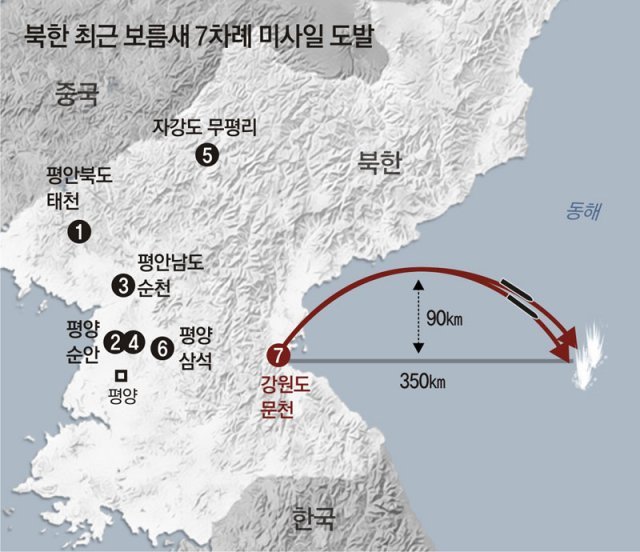 |
(Source: Donga-ilbo) |
October 12, 2022
North Korea fired two long-range strategic cruise missiles that reportedly flew for about 170 minutes and hit a target 1242 miles (2000 km) away into the Yellow sea between Korea and China.
The North’s official Korean Central News Agency (KCNA) said that the test-firing had been “successfully conducted” and that the launches were “aimed at further enhancing the combat efficiency and might of the long-range strategic cruise missiles deployed at the units of the Korean People's Army for the operation of tactical nukes.”(source: The Guardian, Japan Times)
.png) |
North Korea's super-large multiple rocket launchers |
October 14, 2022
① North Korea fired a short-range ballistic missile from the Sunan area in Pyongyang at 1:40 a.m.(KST) towards the East Sea. The missile flew 435 miles, with an apogee of 30 miles and a top speed of Mach 6.
South Korea's National Security Council (NSC) condemned the North for escalating tensions, calling its moves a violation of a 2018 bilateral military pact that bans "hostile acts" in the border area. (source: Reuters)
.png) |
South Korea's F-35 Stealth Fighter responds to North Korea's provocation |
② From 1:20 a.m.(KST), North Korea fired 130 rounds of artillery shells from the west coast. From 2:57 a.m.(KST), North Korea fired 40 rounds of shells off the east coast. At 5:00 p.m. and 5:20 p.m.(KST), North Korea fired again 80 and 200 rounds of shells off the east and west coast.
According to the South’s military, the artillery shots were at least the fourth violation by North Korea since the agreement that was signed during the inter-Korean summit between then-South Korean President Moon Jae-in and North Korean leader Kim Jong Un in Pyongyang in 2018. (source: Yonhap News, The Diplomat)
.png) |
South Korea and U.S. joint military exercises |
③ Around 10 North Korean military aircraft conducted exercises near the inter-Korean border between 10:30 p.m and 12:20 a.m(KST). Some flew as close as 15 miles to the Military Demarcation Line, 7 miles close to the Northern Limit Line, and 3 miles close to the no-fly zone agreed to in the 2018 September 19 military agreement.
South Korea scrambled fighter jets after a group of about 10 North Korean military aircraft flew close to the border dividing the two countries, South Korea's Joint Chiefs of Staff said, amid heightened tensions over repeated North Korean missile tests. (source: Yonhap News, Reuters)
.png) |
South Korea-U.S. joint military exercise of B-1B, F-15K and F-35A |
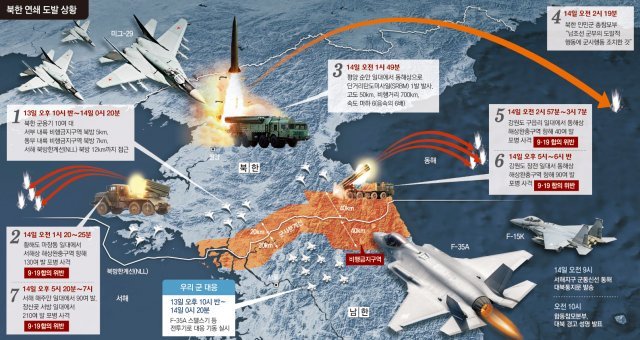 |
(source: Donga-ilbo) |
Oct. 18-19, 2022
At 10 p.m. and 11 p.m.(KST) on October 18, North Korea
fired around 250 artillery shells into waters off its eastern and western
coasts; about 100 rounds of artillery from Jangsan Cape in Hwanghae Province
and around 150 rounds from Jangjon in Kangwon Province into the East Sea. Also, North Korea fired about 100 artillery shells around 12:30 p.m. on October 19
from the Yonan area of South Hwanghae Province.
North Korea's military insisted that the artillery firings into maritime buffer zones near the inter-Korean border set under an inter-Korean military agreement signed on Sept. 19, 2018, were a response to South Korea's annual Hoguk exercise from Oct. 17 to Oct. 28.
But the South's
military conducted live-fire drills involving multiple rocket launchers in
Cheolwon, 71 kilometers northeast of Seoul. South Korea's Joint Chiefs of
Staff announced that the Hoguk field training exercise was for enhancing its combat
readiness and joint force capabilities to counter North Korea's escalating
missile and nuclear threats. (source: The Diplomat, Korea Joongang Daily)
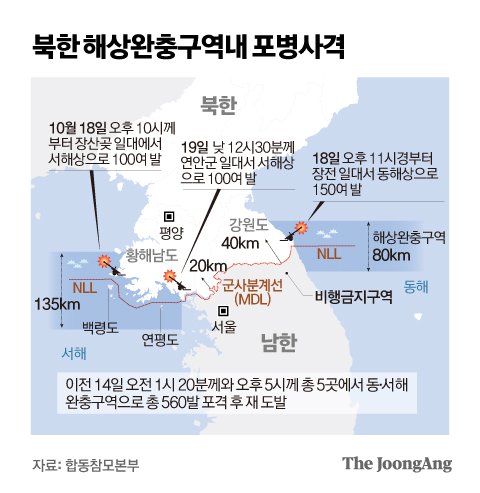 |
(source: Joongang-ilbo) |
Oct. 24, 2022
According to South Korea’s Joint Chiefs of Staff (JCS), a
North Korean freight vessel called the Mupo crossed the NLL at around 3:42
a.m.(KST) on Oct. 24, about 27 kilometers (16.8 miles) northwest of South Korea’s
Baengnyeong Island. It then sailed 3.3 kilometers south.
Despite the
warnings, North Korea's vessel kept sailing south. So the South was quickly
dispatched to nearby waters, coming as close as within 1 kilometer from the
North Korean vessel. South Korea's military fired about 20 warning shots with
an M60 machine gun from the frigate. The Mupo retreated and headed back north
at about 4:20 a.m.
Once the Mupo was back in North Korean waters, the JCS
said Pyongyang fired 10 artillery shots into a buffer zone in the Yellow Sea,
reaching as close to 15 kilometers away from Baengnyeong Island and violating
an inter-Korean military agreement signed on Sept. 19, 2018.
The North Korean vessel's intrusion across the
inter-Korean military demarcation line came hours before the large-scale
combined exercises of South Korea and U.S., part of Hoguk field training
exercise. (source: Yonhap News)
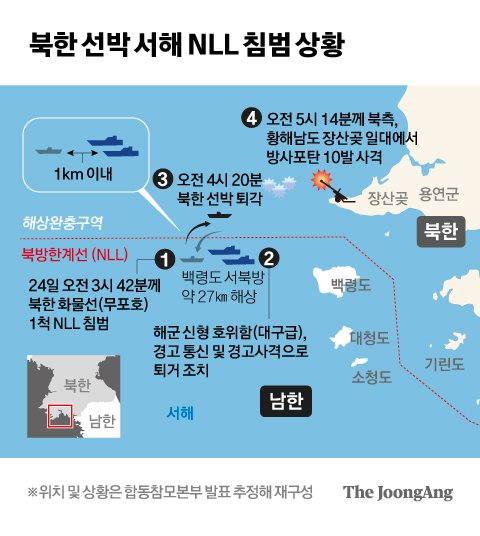 |
(source: Joongang-ilbo) |
Oct. 28, 2022
On Oct. 28, 2022, North Korea launched two short-range
ballistic missiles(SRBMs) from the Tongchon in Kangwon Province toward the East
Sea between 11:59 a.m. and 12:18 p.m.(KST), hours after the Biden administration
warned of toppling Kim Jong-un regime should it launch nuclear attacks against the U.S. and its allies in the Nuclear Posture Review. SRBMs traveled about 230
kilometers at a speed of Mach 5 and an altitude of around 24km, according to
South Korea's JCS.
The launches came as the South was set to conclude its
Hoguk exercise on Oct. 28., and South Korea and the U.S. were also preparing to
stage major combined air drills, Vigilant Storm, from Oct. 31 to Nov. 4.
(source: Korea Herald)
 |
| (source: Yonhap News) |

Comments
Post a Comment